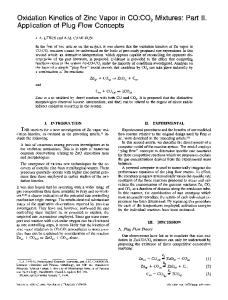Reaction Anisotropy and Size Resolved Oxidation Kinetics of Zinc Nanocrystals
- PDF / 233,305 Bytes
- 6 Pages / 612 x 792 pts (letter) Page_size
- 75 Downloads / 312 Views
1201-H10-39
Reaction Anisotropy and Size Resolved Oxidation Kinetics of Zinc Nanocrystals Xiaofei Ma1 and Michael R. Zachariah1,2 1
2
Department of Mechanical Engineering, University of Maryland-College Park, College Park, MD 20742, U.S.A.
Department of Chemistry and Biochemistry, University of Maryland-College Park, College Park, MD 20742, U.S.A.
Abstract In this work, size-classified substrate-free Zn nanocrystals (NCs) are prepared and investigated for their oxidation kinetics using an in-flight tandem ion-mobility method. The first mobility characterization size selects the NCs, while the second mobility characterization measures changes in mass resulting from a controlled oxidation of the NCs. This method allows for a direct measurement of mass change of individual particles and thus enables us to explore the intrinsic reactivity of NCs while minimizing the sampling error introduced by mass and heat transfer. Two reaction regimes were observed for Zn NC oxidation. A shrinking core model is used to extract the sizedependent oxidation activation energies. We also observed a strong anisotropy effect in the oxidation process as imaged by electron microscopy. An oxidation mechanism is proposed that qualitatively explains the oxidation rate anisotropy and its relationship to the surface energy of the Zn NCs.
Introduction Zn is an attractive fuel and has been employed in powder form as a rocket propellant when mixed with sulfur1. Zinc is also used as the anode or fuel in the zinc-air fuel cell which forms the basis of the theorized zinc economy2. More recently Zn/ZnO redox reactions has been considered for thermo-chemical two-step water-splitting cycles for hydrogen generation3-5. The cycle involves a Zn hydrolysis reaction to produce hydrogen, followed by the solar reduction of zinc oxide. In a recent study6, Zn nanoparticles have been employed so as to take advantage of their high surface to volume ratio and the ability to operate a continuous flow process. As a wide-band-gap semiconductor, bulk ZnO has band gap energy of 3.37 eV at room temperature, and also exhibits piezoelectric properties. ZnO nanostructures such as nanowires/belts have attracted considerable attention due to their novel application in optical and electrical devices, sensors and medical devices7-9. While there exist many different techniques to prepare ZnO, the thermal-oxidation from Zn is the most basic and is widely employed to create a variety of ZnO nanostructures10-14. Despite the widening application of Zn based nanostructures, very little attention has been paid to the quantitative kinetics of Zn nanocrystal (NC) oxidation.
In this paper we use electrical mobility classification and characterization to explore the size resolved reactivity of Zn NCs in free-flight, and determine quantitative Arrhenius reaction parameters. We will also observe that oxidation is anisotropic as imaged from electron-microscopic analysis. What distinguishes this study from previous bulk sample studies, are first, free NCs are suspended in an inert gas e
Data Loading...









